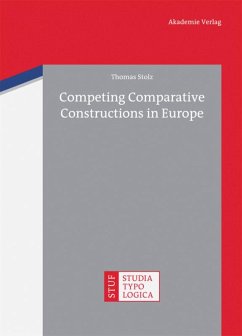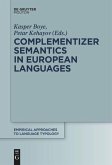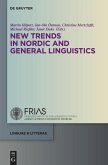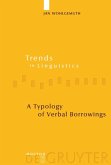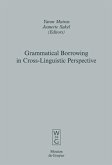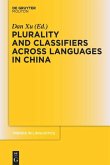This in-depth areal-typological study analyzes the grammatical means which are employed in the languages of Europe to express the comparative of inequality/superiority. The extant theories and hypotheses about the morphosyntactic structure and the cross-linguistic distribution of construction types are reviewed. The behavior of comparatives under the conditions of language contact is discussed. Data from more than 170 standard and nonstandard varieties of European languages are scrutinized systematically. The synchronic picture is complemented by a chapter on the diachrony of comparative constructions. The European facts are compared to those of the geographically adjacent Asian and African regions. It is argued that cross-linguistic investigations must take account also of so-called secondary options. These secondary options suggest strongly that the supposedly dominant role of the particle comparative cannot be upheld for Europe. Moreover, only the secondary options allow us to draw isoglosses which cross the borders between Europe and Asia (and Africa).
Diese arealtypologische Studie untersucht die grammatischen Mittel, die in den Sprachen Europas verwendet werden, um den Komparativ der Ungleichheit/Überlegenheit auszudrücken. Die bestehenden Theorien und Hypothesen über die morphosyntaktische Struktur und die crosslinguistische Verteilung von Konstruktionstypen werden durchgemustert; das Verhalten von Komparativen unter den Bedingungen des Sprachkontakts wird diskutiert. Dabei werden Daten aus mehr als 170 Standard- und Nichtstandardvarietäten europäischer Sprachen systematisch untersucht. Das synchrone Bild wird um Überlegungen zur die Diachronie von Komparativkonstruktionen ergänzt, die europäischen Fakten zudem mit denen der asiatischen und afrikanischen Regionen verglichen. Es wird dafür argumentiert, dass crosslinguistische Untersuchungen auch so genannte sekundäre Optionen berücksichtigen müssen. Diese sekundären Optionen sprechen dafür, dass die vermeintlich dominante Rolle des Partikelkomparativs für Europa nicht aufrechterhalten werden kann. Darüber hinaus erlauben es uns nur die sekundären Optionen, Isoglossen aufzustellen, die die Grenzen zwischen Europa und Asien (sowie Afrika) überschreiten.
Diese arealtypologische Studie untersucht die grammatischen Mittel, die in den Sprachen Europas verwendet werden, um den Komparativ der Ungleichheit/Überlegenheit auszudrücken. Die bestehenden Theorien und Hypothesen über die morphosyntaktische Struktur und die crosslinguistische Verteilung von Konstruktionstypen werden durchgemustert; das Verhalten von Komparativen unter den Bedingungen des Sprachkontakts wird diskutiert. Dabei werden Daten aus mehr als 170 Standard- und Nichtstandardvarietäten europäischer Sprachen systematisch untersucht. Das synchrone Bild wird um Überlegungen zur die Diachronie von Komparativkonstruktionen ergänzt, die europäischen Fakten zudem mit denen der asiatischen und afrikanischen Regionen verglichen. Es wird dafür argumentiert, dass crosslinguistische Untersuchungen auch so genannte sekundäre Optionen berücksichtigen müssen. Diese sekundären Optionen sprechen dafür, dass die vermeintlich dominante Rolle des Partikelkomparativs für Europa nicht aufrechterhalten werden kann. Darüber hinaus erlauben es uns nur die sekundären Optionen, Isoglossen aufzustellen, die die Grenzen zwischen Europa und Asien (sowie Afrika) überschreiten.

